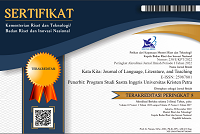The Cloud over My Head and Other Stories: Children’s Picture Books on Children’s Anxiety
DOI:
https://doi.org/10.9744/katakita.9.3.406-412Keywords:
Foto esai, Kain tenun, Bentenan, Manado, Sulawesi Utara, Tekstil.Abstract
This creative work is in five children’s picture book format for the target of age five to nine and the topic focuses on children’s anxiety. My stories will be in low fantasy genre, where the anxiety in each story has various forms. The main theme of my stories is to show that what anxiety produces negative thoughts that are not based on reality. To show how children can have anxiety, I use Cognitive Distortions theory, and to show how children can cope with their anxieties, I use Cognitive Behavioural Therapy (CBT) theory. Each of my stories will be about how anxiety happens to the main character and how the main character solves the problem. From the research I did, I found that anxiety happens to children and it produces negative thoughts that are later proven to be untrue. With CBT, children can also learn how to cope their anxieties by self-monitoring their own emotions and turn negative thoughts into positive ones.
Keywords: Children, anxiety, cognitive distortions, cognitive behavioural therapy
References
Burns, David. (1980) Feeling good the new mood therapy. William Morrow and Company, Inc.
Carmody, A. (2020, June 9). High fantasy vs low fantasy: A detailed guide. https://fantasybookfanatic.com/high-fantasy-vs-low-fantasy-a-detailed-guide/.
Chavira, D. A., Bantados, B., Rapp, A., Firpo-Perretti, Y. M., Escovar, E., Dixon, L., … Palinkas, L. A. (2017, May). Parent-reported stigma and child anxiety: A mixed methods research study. Children and youth services review. https://dx.doi.org/10.1016%2Fj.childyouth.2017.03.013
Clark, D. A., & Beck, A. T. (2011). Cognitive therapy of anxiety disorders: Science and practice. The Guilford Press.
Martinelli, K., Cohen, Y., Kimball, H., & Miller, C. (2018). Understanding anxiety in children and teens. Child Mind Institute.
MasterClass. (2020, November 8). Sharpen your writing skills: Internal vs. external conflict and 3 tips for adding conflict to your writing - 2021. MasterClass. https://www.masterclass.com/articles/sharpen-your-writing-skills-internal-vs-external-conflict.
McNulty, B. (2019, August 13). External and internal conflict: Examples and tips. Now Novel. https://www.nownovel.com/blog/difference-external-internal-conflict-writing/.
Minde, K., Roy, J., Bezonsky, R., & Hashemi, A. (2010, May). The effectiveness of CBT in 3-7 year old anxious children: Preliminary data. Journal of the Canadian Academy of Child and Adolescent Psychiatry. https://www.ncbi.nlm.nih.gov/pmc/articles/PMC2868557/
Parker, L. E., & Lepper, M. R. (1992). Effects of fantasy contexts on children's learning and motivation: Making learning more fun. Journal of Personality and Social Psychology, 62(4), 625–633. https://doi.org/10.1037/0022-3514.62.4.625
Pereira, A. I. F., Barros, L., & Mendonça, D. (2012). Cognitive errors and anxiety in school aged children. Psicologia: Reflexão e Crítica, 25(4), 817–823. https://doi.org/10.1590/s0102-79722012000400022
Stallard, P. (2002). Think good, feel good: A cognitive behavioural therapy workbook for young people. Wiley.
Strouse, G. A., Nyhout, A., & Ganea, P. A. (2018). The role of book features in young children's transfer of information from picture books to real-world contexts. Frontiers in Psychology, 9. https://doi.org/10.3389/fpsyg.2018.00050
Downloads
Published
Issue
Section
License
Authors who publish with this journal agree to the following terms:- Authors retain copyright and grant the journal right of first publication with the work simultaneously licensed under a Creative Commons Attribution License that allows others to share the work with an acknowledgement of the work's authorship and initial publication in this journal.
- Authors are able to enter into separate, additional contractual arrangements for the non-exclusive distribution of the journal's published version of the work (e.g., post it to an institutional repository or publish it in a book), with an acknowledgement of its initial publication in this journal.
- Authors are permitted and encouraged to post their work online (e.g., in institutional repositories or on their website) prior to and during the submission process, as it can lead to productive exchanges, as well as earlier and greater citation of published work (See The Effect of Open Access).














